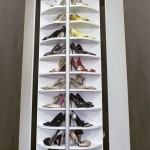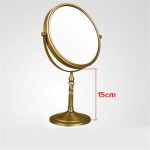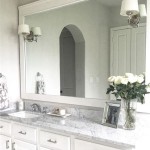How To Mount a Wall Mirror Without Drilling
Mounting a wall mirror can significantly enhance the aesthetics of a room, adding light and creating a sense of space. However, the prospect of drilling holes in walls can be daunting, particularly in rented apartments or homes with delicate surfaces. Fortunately, several effective methods exist for mounting a wall mirror without drilling, offering a damage-free and convenient alternative. This article explores various techniques, materials, and considerations for successfully mounting a mirror without resorting to traditional drilling methods.
Choosing the right method for mounting a mirror without drilling depends on several factors, including the size and weight of the mirror, the type of wall surface, and the desired permanence of the installation. Careful assessment of these factors is crucial to ensure a secure and long-lasting result. Improper application of alternative methods can lead to mirror detachment, potentially causing damage and injury.
Selecting the Right Adhesive for Your Mirror
Adhesive-based mounting solutions are a popular choice for hanging mirrors without drilling. The success of this method relies heavily on selecting an appropriate adhesive that can adequately support the weight of the mirror and bond effectively with both the mirror's backing and the wall surface. Several types of adhesives are commonly used, each with its own advantages and limitations.
Mirror-specific adhesives are formulated to provide a strong, permanent bond without damaging the reflective coating on the back of the mirror. These adhesives are typically neutral-cure silicones or modified polymer-based products, designed to be compatible with the silver or aluminum backing commonly found on mirrors. Using a non-mirror-specific adhesive can lead to discoloration, chemical reactions, or even delamination of the mirror's reflective layer, resulting in irreversible damage.
Construction adhesives, also known as multi-purpose adhesives, are another option, offering a strong bond suitable for a variety of surfaces. However, it is crucial to ensure that the chosen construction adhesive is explicitly labeled as mirror-safe to avoid potential damage. Check the manufacturer's specifications to confirm compatibility and weight-bearing capacity. Furthermore, construction adhesives often require a longer curing time than mirror-specific adhesives, so proper support during the curing process is essential.
Double-sided adhesive tapes, particularly those designed for heavy-duty applications, can also be used for mounting mirrors. These tapes come in various thicknesses and strengths, and the selection should be based on the weight of the mirror and the texture of the wall. For heavier mirrors or textured walls, thicker, high-bond tapes are recommended. It's important to note that double-sided tapes may not provide as permanent a bond as liquid adhesives and may be more susceptible to temperature and humidity changes. Surface preparation is especially critical when using double-sided tape, ensuring that both the mirror backing and wall surface are clean, dry, and free of dust or grease.
Preparation is Key: Ensuring a Successful Installation
Proper preparation is paramount for a successful, drill-free mirror installation. Neglecting this crucial step can result in a weak bond, leading to the mirror detaching from the wall. This preparation involves cleaning the surfaces, marking the position, and taking necessary precautions to protect the surrounding area.
The first step is to thoroughly clean both the back of the mirror and the wall surface where the mirror will be mounted. Use a clean, lint-free cloth and a mild detergent to remove any dirt, dust, grease, or residue. For stubborn stains or grease, isopropyl alcohol can be used, but ensure it is completely evaporated before applying any adhesive. A clean surface ensures optimal adhesion and prevents contaminants from interfering with the bonding process.
Accurately mark the desired position of the mirror on the wall using a level and measuring tape. This will help ensure that the mirror is hung straight and in the correct location. Use a pencil to lightly trace the outline of the mirror on the wall, providing a visual guide for adhesive placement. For larger mirrors, it can be helpful to use painter's tape to create a border around the marked area, protecting the surrounding wall from accidental adhesive smudges.
Consider the weight of the mirror and the type of wall surface when deciding on the amount and placement of the adhesive. For heavier mirrors, apply adhesive in a vertical pattern, covering a significant portion of the mirror's back surface. This distributes the weight more evenly and provides a stronger bond. For textured walls, use a thicker layer of adhesive to fill in any gaps and ensure good contact. It's also advisable to use temporary supports, such as painter's tape or shims, to hold the mirror in place while the adhesive cures. This prevents the mirror from sliding down the wall and ensures a secure bond during the critical curing period.
Exploring Alternative, Non-Adhesive Mounting Options
While adhesives are a common solution for drill-free mirror mounting, alternative methods exist that rely on mechanical support or tension, offering potentially removable or adjustable options. These methods can be particularly useful for renters or individuals who prefer a less permanent installation.
Heavy-duty adhesive hooks are designed to support significant weight and can be a viable option for smaller, lightweight mirrors. These hooks typically utilize a strong adhesive backing and are available in various sizes and weight capacities. When using adhesive hooks, it is crucial to select hooks that are rated for the weight of the mirror plus a safety margin. Follow the manufacturer's instructions carefully for proper installation, ensuring that the wall surface is clean and dry before applying the hooks. Also, allow the adhesive to cure fully before hanging the mirror to ensure a secure bond.
Tension rods, commonly used for shower curtains or closet organizers, can be adapted for mounting mirrors in specific situations. This method requires a recessed area or alcove where the tension rod can be securely placed. The mirror can then be hung from the tension rod using hooks or wire. This approach is particularly suitable for temporary installations or when the mirror needs to be easily moved or adjusted. Ensure the tension rod is rated to hold the weight of the mirror and is installed securely to prevent it from slipping or falling.
Another less common but potentially viable option is to utilize existing architectural features, such as shelves or ledges, to support the mirror. This method requires careful planning and consideration of the mirror's size and weight. The mirror can be placed on the shelf or ledge and secured using non-slip pads or wedges to prevent it from sliding or tipping over. This approach may require custom-building a shelf or ledge specifically designed to support the mirror. Safety is paramount when using this method, ensuring that the mirror is stable and cannot be easily knocked over.
Ultimately, selecting the best method for mounting a mirror without drilling requires careful assessment of the mirror's weight and dimensions, the wall surface, and the desired permanence of the installation. Thorough preparation and adherence to the manufacturer's instructions are crucial for ensuring a secure and damage-free mounting experience.
Each of these methods has its own set of pros and cons. Adhesive methods prioritize a clean, flush finish but require careful adhesive selection and wall preparation. Non-adhesive methods offer flexibility and potential reusability but may require more setup and structural consideration.
Before commencing any installation, it is recommended to test the chosen method in an inconspicuous area of the wall. This allows for assessment of the adhesive's bond strength and potential impact on the wall surface before committing to the final installation. Consultation with a professional handyman or contractor can also provide valuable insights and guidance, particularly for larger or more complex mirror installations.

3 Simple Ways To Hang A Mirror On Wall Without Nails Wikihow

3 Simple Ways To Hang A Mirror On Wall Without Nails Wikihow

Hang Mirror Without Nail Or

3 Simple Ways To Hang A Mirror On Wall Without Nails Wikihow

How To Install A Mirror Without Frame Merrypad

3 Simple Ways To Hang A Mirror On Wall Without Nails Wikihow

3 Simple Ways To Hang A Mirror On Wall Without Nails Wikihow

Hang Fabric On Wall Without Nails Clearance

How To Hang A Heavy Mirror Or Picture Right The First Time

How To Install A Mirror Without Frame Merrypad








